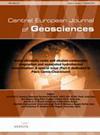Stratigraphy and depositional environments of the Mamfe Formation and its implication on the tectonosedimentary evolution of the Ikom-Mamfe Embayment, West Africa
引用次数: 21
Abstract
A 42 m thick outcropping portion of the Mamfe Formation is subdivided into Manyu (31 m thick) and Kesham (11m thick) Members on the basis of textural, mineralogical and structural differences. The Manyu Member (Albian) consists of folded and indurated, medium to coarse grained arkosic sandstones and thickly laminated organic-rich shales deposited in a lacustrine environment. The Kesham Member (Cenomanian) consists of subarkoses intercalated with massive green shale and mudstone deposited in a fluvial environment. The change in depositional environment was tectonically controlled. The mid Cretaceous paleogeography of the embayment was governed by the NE-SW trending “Ikom ridge” which prevented marine incursion from adjacent the Benue Sea. Evaporites found within the basin were precipitated from ocean water that was periodically spilled by strong tides and storms across the ridge into the embayment. The filling-up of the embayment to base level in the Cenomanian resulted in a shift in the depositional center downstream to adjoining lower Benue Trough. Similarity in heavy mineral composition and maturity of the Cenomanian sandstones with recent clastics in the embayment indicates their derivation from the same source terrain and relatively stable tectonic and climatic conditions at the source area since the Cenomanian time.西非ikomm -Mamfe组地层、沉积环境及其对构造-沉积演化的意义
根据构造、矿物学和构造的差异,将马铁组42 m厚的露头部分划分为满峪段(31 m厚)和克山段(11m厚)。满峪段(Albian)为湖相沉积,由褶皱硬化的中粗粒黑质砂岩和厚层状富有机质页岩组成。克尚段(Cenomanian)由河流环境下的块状绿色页岩和泥岩夹层组成。沉积环境的变化受构造控制。中白垩世海湾古地理受北东-西南走向的“Ikom脊”支配,阻止了邻近贝努埃海的海相入侵。在盆地内发现的蒸发岩是由海水沉淀而成的,这些海水周期性地由强烈的潮汐和风暴溢出,穿过山脊进入海湾。塞诺曼尼亚期海槽向基准面的填充物导致沉积中心向下游的贝努埃海槽移动。塞诺曼期砂岩重矿物组成和成熟度与河口近期碎屑岩相似,表明它们来源于同一源区地形,源区自塞诺曼期以来构造和气候条件相对稳定。
本文章由计算机程序翻译,如有差异,请以英文原文为准。
求助全文
约1分钟内获得全文
求助全文
来源期刊

Central European Journal of Geosciences
GEOSCIENCES, MULTIDISCIPLINARY-
自引率
0.00%
发文量
0
审稿时长
>12 weeks
 求助内容:
求助内容: 应助结果提醒方式:
应助结果提醒方式:


